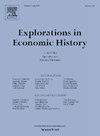Family first: Defining, constructing, and applying historical patent families
IF 1.7
1区 历史学
Q1 ECONOMICS
引用次数: 0
Abstract
The article presents a novel method that enables the formation of historical patent families. Patent families are useful for studying the value of inventions and identifying key technologies, as they indicate geographic diffusion and higher patenting costs. The concept of patent family has not been employed in historical contexts as historical sources generally lack information about priority rights. The article provides a definition of a historical patent family, where patent families incorporate patents with the same invention core. The method is applied and evaluated by constructing Swedish patent families in 1885–1914 with historical patent data from Finland and the United States. Moreover, the article introduces the Patent Diffusion Index (PDI), which is an indicator of historical patent families which can be used to study the sequence and pace of market entry. The article exemplifies how historical patent families open novel perspectives on patent value and technology diffusion in contrast to current indicators, such as patent fees, which usually are bound to national contexts. The method is applicable to any national patent data, and patent drawings are suggested as an effective way to form historical patent families.
家族第一:定义、构建和应用历史专利族
文章介绍了一种能够形成历史专利族的新方法。专利族对于研究发明价值和识别关键技术非常有用,因为它们表明了专利的地域扩散和较高的专利成本。由于历史资料通常缺乏优先权方面的信息,因此专利族的概念尚未在历史背景下使用。本文给出了历史专利族的定义,即专利族包括具有相同发明核心的专利。通过利用芬兰和美国的历史专利数据构建 1885-1914 年的瑞典专利族,对该方法进行了应用和评估。此外,文章还介绍了专利扩散指数(PDI),这是历史专利族的一个指标,可用于研究市场进入的顺序和速度。文章举例说明了历史专利族如何为专利价值和技术扩散开辟了新的视角,与专利费等通常受国家背景约束的现行指标形成鲜明对比。该方法适用于任何国家的专利数据,并建议将专利图纸作为形成历史专利族的有效方法。
本文章由计算机程序翻译,如有差异,请以英文原文为准。
求助全文
约1分钟内获得全文
求助全文
来源期刊

Explorations in Economic History
Multiple-
CiteScore
2.50
自引率
8.70%
发文量
27
期刊介绍:
Explorations in Economic History provides broad coverage of the application of economic analysis to historical episodes. The journal has a tradition of innovative applications of theory and quantitative techniques, and it explores all aspects of economic change, all historical periods, all geographical locations, and all political and social systems. The journal includes papers by economists, economic historians, demographers, geographers, and sociologists. Explorations in Economic History is the only journal where you will find "Essays in Exploration." This unique department alerts economic historians to the potential in a new area of research, surveying the recent literature and then identifying the most promising issues to pursue.
 求助内容:
求助内容: 应助结果提醒方式:
应助结果提醒方式:


